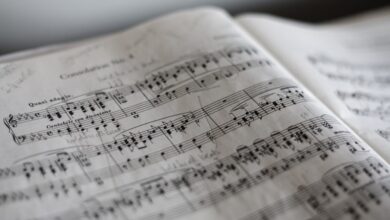Unlocking the Secrets of Music Composition

Are you ready to dive into the mesmerizing world of music composition? Whether you’re an aspiring musician or simply a curious listener, understanding the secrets behind the creation of captivating melodies and harmonies can unlock a whole new level of appreciation for the art form. In this article, we’ll explore the fascinating realm of music composition and shed light on the process that brings sonic masterpieces to life.

At its core, music composition is like weaving a magical tapestry with sound. It’s a delicate balance between creativity and technicality, where composers harness their imagination to craft musical narratives that stir emotions within us. But what exactly goes into composing a piece of music?
Imagine a composer as a skilled architect, meticulously constructing a musical structure from the ground up. They start by selecting a key, which acts as the foundation for the composition. Just like the blueprint for a building, the chosen key sets the overall mood and tonality of the piece. From there, the composer establishes the tempo, rhythm, and meter, dictating the pulse and flow of the music.
Next, the composer explores melodies, the heart and soul of any composition. Melodies are like the vibrant colors that paint a musical canvas, guiding listeners through a sonic journey. They can be soaring and triumphant, gentle and introspective, or anything in between. The composer crafts these melodic phrases, carefully considering their contour, intervals, and emotional impact.

In addition to melodies, harmonies play a crucial role in music composition. Think of harmonies as the supporting pillars that enhance and enrich the melody. They add depth and complexity, creating a lush musical landscape. Composers experiment with chords and progressions, blending dissonance and consonance to create tension and resolution, just like the ebb and flow of life itself.
But it doesn’t stop there. A composer also embraces dynamics, articulation, and instrumentation to add texture and nuance to their composition. They may decide to incorporate various instruments, each with its own unique timbre, to create a symphony of voices that intertwine harmoniously.

Unlocking the secrets of music composition takes time, dedication, and an unwavering passion for the art. It’s an ever-evolving process where composers push boundaries, experiment with new sounds, and channel their emotions into musical expression. So, the next time you listen to a piece of music, let yourself be captivated by the intricate web of creativity that lies beneath the surface, knowing that you are experiencing the result of a composer’s labor of love.
Music composition is a captivating journey that combines creativity, technical skill, and emotional expression. By understanding the intricacies of key selection, melody crafting, harmonies, dynamics, and instrumentation, we gain a deeper appreciation for the artistry behind every musical masterpiece. So, let the secrets of music composition unlock a newfound wonder in your heart as you embark on this enchanting sonic voyage.
Breaking the Code: Unveiling the Hidden Techniques Behind Music Composition
Are you ready to embark on a journey that unravels the enigmatic art of music composition? Brace yourself as we delve into the hidden techniques that breathe life into captivating melodies and harmonies. In this article, we will explore the secrets behind crafting unforgettable musical pieces, guiding you through the creative process of composing music.
At the heart of music composition lies the mastery of melody. Melodies are the soul-stirring threads that weave their way through our hearts and minds. Artists carefully select notes, shaping them into a sequence that resonates with our emotions. Just like an eloquent storyteller, composers use melodic motifs to captivate listeners and convey their intended message. Think of melodies as the vocalizations of our innermost thoughts, expressed through the language of music.
Harmony, the marriage of multiple notes played simultaneously, adds depth and color to compositions. Composers skillfully combine chords, arranging them in unique progressions to create a rich tapestry of sound. Harmonies can evoke feelings of joy, sadness, tension, or resolution, allowing us to experience a myriad of emotions within a single piece of music. They are the skilled painters who apply brushstrokes of harmony, transforming a simple melody into a masterpiece.
Rhythm is the heartbeat of music, providing structure and groove. It encompasses the arrangement of notes in time, creating patterns that give music its distinctive flow. Composers utilize rhythm to establish pace, build anticipation, and introduce variation. By playing with accents and syncopation, they inject energy and excitement into their compositions, making us tap our feet and move to the beat.
Texture, another essential aspect of music composition, refers to the layers and interplay of different musical elements. Like a master architect, composers carefully construct the arrangement of instruments or voices, shaping the overall sonic landscape. Varying the density and timbre of these layers adds depth and complexity to the music, painting a vivid sonic picture that resonates with our senses.
As we conclude this exploration of the hidden techniques behind music composition, let us appreciate the artistic brilliance that lies within every musical creation. Composers are the magicians who weave together melodies, harmonies, rhythms, and textures, transforming mere notes into a symphony of emotions. They break the code, unveiling the secrets that touch our souls and leave an indelible mark on the world of music.
So, next time you find yourself lost in a captivating melody or moved by a powerful chord progression, remember the intricate craftsmanship behind it all. Music composition is a tapestry of creativity, skill, and passion—an art form that continues to inspire, uplift, and connect us all.
Decoding the Melodies: How Music Composers Craft Emotion through Sound

Have you ever wondered how a simple combination of sounds can evoke powerful emotions within us? The art of music composition is nothing short of mesmerizing. Talented music composers have the incredible ability to create sonic landscapes that touch our souls and transport us to different emotional realms. In this article, we will delve into the fascinating world of music composition and explore how composers craft emotion through sound.
At its core, music is an expressive language that communicates emotions without the need for words. It has the power to make us feel joy, sadness, excitement, or nostalgia. But how do composers achieve this profound impact? They employ a variety of techniques that engage our senses and trigger emotional responses.
One of the key elements in crafting emotion through sound is melody. Melodies are the captivating sequences of musical notes that form the backbone of a composition. Composers carefully construct melodies using a combination of pitch, rhythm, and timing to create specific emotional atmospheres. A gentle and flowing melody might evoke feelings of tranquility and peace, while a fast-paced and dissonant melody could generate tension and unease.
Another essential tool in a composer’s arsenal is harmony. Harmony refers to the simultaneous sounding of different musical notes that complement each other. By manipulating harmonies, composers can create a sense of tension or resolution, heightening the emotional impact of their compositions. Just like colors on an artist’s palette, harmonies can be blended together to paint a vivid emotional landscape.
Rhythm plays an equally important role in evoking emotions through music. The rhythmic patterns and beats set the pace and energy of a piece. A slow, steady rhythm can instill a sense of calmness, while a lively and syncopated rhythm might ignite feelings of excitement and vitality. Composers skillfully employ rhythm to establish the emotional heartbeat of their compositions.
Additionally, composers make deliberate choices regarding instrumentation and timbre. Different musical instruments possess unique qualities that can elicit specific emotions. For instance, the warm and mellow tones of a cello may evoke melancholy, while the bright and crisp sounds of a trumpet could convey triumph or celebration. By selecting the right instruments and blending their timbres, composers create a rich tapestry of emotions.
Music composers are true magicians who weave emotional tapestries with their melodies, harmonies, rhythms, and instrumental choices. Through their craft, they have the extraordinary ability to reach deep within us and stir our souls. So, the next time you find yourself captivated by a piece of music, take a moment to appreciate the intricate details and the immense power with which composers decode the language of emotions through the enchanting realm of sound.
Harmony Unleashed: Exploring the Key Elements of Music Composition
Are you ready to embark on a mesmerizing journey into the enchanting world of music composition? Brace yourself, as we delve into the intricate web of melodies, harmonies, and rhythms that form the backbone of every musical masterpiece. In this article, we will unravel the key elements of music composition and discover how they blend together to create a symphony that resonates with our souls.
Melody, the soul-stirring essence of any composition, takes center stage in this musical odyssey. It is the beautiful thread that weaves through the entire composition, leaving an indelible mark on our hearts. A captivating melody has the power to transport us to distant lands, stir emotions, and ignite our imagination. Just like a storyteller spins a tale, a composer crafts a melody that enchants and captivates the listener’s ear.
But what gives a melody its wings? Enter harmony, the companion of melody, guiding it towards sublime heights. Harmony adds depth, richness, and complexity to a composition. It is the interplay of different musical notes, chords, and progressions that creates a tapestry of sound, elevating the melody to new dimensions. Think of harmony as the colors on an artist’s palette, blending together to create a vivid and enthralling visual experience for the listener’s ears.
Rhythm, the pulse of music, infuses life and energy into a composition. It is the heartbeat that propels the melody forward, creating a sense of movement and groove. Just like a choreographer orchestrates dancers, a composer orchestrates rhythm, playing with accents, pauses, and patterns to create a dynamic and compelling musical flow. Rhythm sets the stage for our body to sway and our feet to tap in synchrony with the music.
Instruments, the messengers of music, breathe life into compositions. Whether it’s the delicate strumming of a guitar, the melancholic cry of a violin, or the thunderous roar of drums, each instrument adds its unique voice, texture, and character to the composition. Like an ensemble of actors on a stage, instruments come together to create a harmonious dialogue, expressing the composer’s vision in a symphony of sound.
As we conclude our exploration of the key elements of music composition, let us marvel at how these elements intertwine, intertwine like vines in a lush garden. Melody, harmony, rhythm, and instruments dance together, creating a masterpiece that transcends words and touches the deepest recesses of our souls. So next time you listen to a piece of music, close your eyes, open your heart, and let the harmony be unleashed within you.
From Mozart to Modernity: Evolutionary Insights into Music Composition
Introduction:
Have you ever wondered how music composition has evolved over the centuries? From the classical masterpieces of Mozart to the groundbreaking innovations of modern composers, the journey of music creation is a fascinating one. In this article, we will delve into the evolutionary insights that have shaped the art of music composition, exploring the transformative trends and techniques that have captivated audiences throughout history.
The Language of Emotion:
Just like spoken words, music has its own language—one that transcends cultural barriers and communicates directly with our emotions. Composers have long understood this power and have strived to harness it to evoke specific feelings in their listeners. From the elegant symphonies of Mozart, which embodied grace and poise, to the romantic melodies of Chopin, which stirred passion and longing, each era brought forth its unique emotional tapestry.
Breaking Boundaries:
As time progressed, composers dared to challenge the established norms and push the boundaries of musical expression. The Romantic period witnessed a surge of individualism, where composers like Beethoven infused their compositions with raw intensity and personal narratives. This departure from traditional structures set the stage for the experimentation and artistic freedom that defined the modern era.
Innovation and Technology:
The advent of technology further propelled music composition into new realms. With the invention of the piano, composers gained a versatile instrument capable of an extensive range of sounds. Eventually, the birth of electronic instruments and synthesizers opened doors to unprecedented sonic possibilities, enabling composers to explore uncharted territories of soundscapes and textures.
Rhythmic Revolution:
From the steady beats of classical compositions to the complex rhythms found in jazz and contemporary genres, rhythm has played a pivotal role in the evolution of music composition. The syncopated rhythms of ragtime and the polyrhythms of African music influenced the development of jazz, while the pulsating beats of rock and electronic music reshaped the landscape of popular culture.
A Fusion of Genres:
In recent times, composers have embraced a fusion of genres, blending classical elements with contemporary styles. This amalgamation has resulted in captivating compositions that bridge the gap between tradition and innovation. From symphonic rock to electronic classical hybrids, these boundary-breaking works appeal to a diverse audience, uniting fans of different musical backgrounds.

Conclusion:
As we reflect on the journey from Mozart to modernity, it becomes evident that music composition is an ever-evolving art form. It continues to push boundaries, evoke emotions, and transcend the limitations of language. By embracing new technologies, experimenting with rhythms, and fusing different genres, composers have shaped the landscape of music, leaving us in awe and anticipation of what lies ahead. Let us celebrate this remarkable evolution and embrace the transformative power of music.




